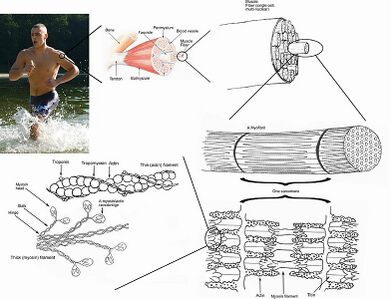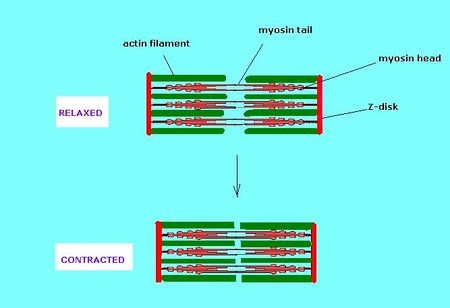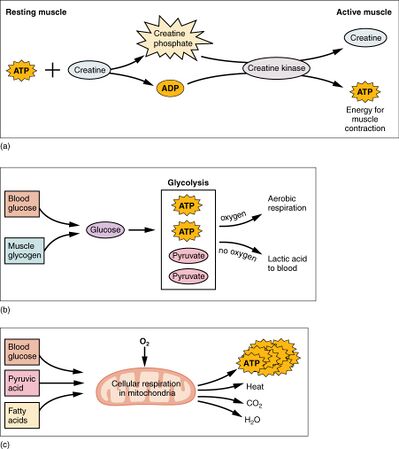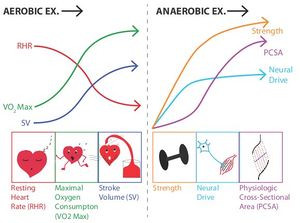Muscle Fibre Types
Original Editor - Lucinda hampton
Top Contributors - Lucinda hampton
Introduction[edit | edit source]
Human skeletal muscle is composed of a heterogenous collection of muscle fiber types. This range of muscle fiber types allows for the wide variety of capabilities that human muscles display.
The three types of muscle fibres are slow oxidative (SO), fast oxidative (FO) and fast glycolytic (FG). Most skeletal muscles in a human contain(s) all three types, although in varying proportions. In addition, muscle fibers can adapt to changing demands by changing size or fiber type composition.
This plasticity serves as the physiologic basis for numerous physical therapy interventions designed to increase a patient's force development or endurance. Changes in fiber type composition also may be partially responsible for some of the impairments and disabilities seen in patients who are deconditioned because of prolonged inactivity, limb immobilization, or muscle denervation.[1]
Classification[edit | edit source]
Skeletal muscle fibers can be classified based on two criteria: 1.How fast do fibers contract relative to others. 2 How do fibers regenerate ATP[2].
- Type 1: Slow oxidative (SO) fibers contract relatively slowly and use aerobic respiration (oxygen and glucose) to produce ATP. They produce low power contractions over long periods and are slow to fatigue.
- Type 2 A: Fast oxidative (FO) fibers have fast contractions and primarily use aerobic respiration, but because they may switch to anaerobic respiration (glycolysis), can fatigue more quickly than SO fibers.
- Type 2 B: Fast glycolytic (FG) fibers have fast contractions and primarily use anaerobic glycolysis. The FG fibers fatigue more quickly than the others[3].
Type 1[edit | edit source]
Type I fibers (SO). These fibers have a rich capillary supply, numerous mitochondria and aerobic respiratory enzymes, and a high concentration of myoglobin. Myoglobin is a red pigment, similar to the hemoglobin in red blood cells, that improves the delivery of oxygen to the slow-twitch fibers. Because of their high myoglobin content, slow-twitch fibers are also called red fibers.[3]
The fact that SO fibers can function for long periods without fatiguing makes them useful in maintaining posture, producing isometric contractions, stabilizing bones and joints, and making small movements that happen often but do not require large amounts of energy. They do not produce high tension, and thus they are not used for powerful, fast movements that require high amounts of energy and rapid cross-bridge cycling.[3]
Type 2A[edit | edit source]
Type 2A (FO) fibers are sometimes called intermediate fibers because they possess characteristics that are intermediate between fast fibers and slow fibers. They produce ATP relatively quickly, more quickly than SO fibers, and thus can produce relatively high amounts of tension. They are oxidative because they produce ATP aerobically, possess high amounts of mitochondria, and do not fatigue quickly. However, FO fibers do not possess significant myoglobin, giving them a lighter color than the red SO fibers. FO fibers are used primarily for movements, such as walking, that require more energy than postural control but less energy than an explosive movement, such as sprinting. FO fibers are useful for this type of movement because they produce more tension than SO fibers but they are more fatigue-resistant than FG fibers.[3]
Type 2B[edit | edit source]
Type 2B (FG) fibers primarily use anaerobic glycolysis as their ATP source. They have a large diameter and possess high amounts of glycogen, which is used in glycolysis to generate ATP quickly to produce high levels of tension. Because they do not primarily use aerobic metabolism, they do not possess substantial numbers of mitochondria or significant amounts of myoglobin and therefore have a white color. FG fibers are used to produce rapid, forceful contractions to make quick, powerful movements. These fibers fatigue quickly, permitting them to only be used for short periods[3].
Note: Type IIb muscle fibers are actually type IIx fibers. So keep this in mind when you find yourself reading further about muscle fibers.[4]
Speed of Contraction[edit | edit source]
The speed of contraction is dependent on how quickly myosin’s ATPase hydrolyzes ATP to produce cross-bridge action. Fast fibers hydrolyze ATP approximately twice as rapidly as slow fibers, resulting in much quicker cross-bridge cycling (which pulls the thin filaments toward the center of the sarcomeres at a faster rate).[2]e
eg. The extraocular muscles that position the eyes have a high proportion of fast-twitch fibers and reach maximum tension in about 7.3 msec (milliseconds—thousandths of a second). The soleus muscle in the leg, by contrast, has a high proportion of slow-twitch fibers and requires about 100 msec to reach maximum tension[5].
Numbers of Slow and Fast-Twitch Fibers[edit | edit source]
The number of slow and fast-twitch fibers contained in the body varies greatly between individuals and is determined by a person’s genetics. People who do well at endurance sports tend to have a higher number of slow-twitch fibers, whereas people who are better at sprint events tend to have higher numbers of fast-twitch muscle fibers. Both the slow twitch and fast-twitch fibers can be influenced by training. It is possible through sprint training to improve the power generated by slow twitch fibers, and through endurance training, it is possible to increase the endurance level of fast-twitch fibers. The level of improvement varies, depending on the individual, and training can never make slow-twitch fibers as powerful as fast-twitch, nor can training make fast-twitch fibers as fatigue resistant as slow-twitch fibers[6].
Ageing[edit | edit source]
Age-related loss of muscle mass results primarily from a decrease in the total number of both type I and type II fibers and, secondarily, from a preferential atrophy of type II fibers. See Sarcopenia.
- Atrophy of type II fibers leads to a larger proportion of slow type muscle mass in aged muscle, as evidenced by slower contraction and relaxation times in older muscle.
- In addition, the loss of alpha motoneurons with age results in some reinnervation of“abandoned” muscle fibers by adjacent motor units that may be of a different type. This may facilitate fiber type conversion, as the reinnervated muscle fibers take on the properties of the new“parent” motor unit[1].
Note: Alpha motor neurons innervate extrafusal muscle fibers and are the primary means of skeletal muscle contraction. Gamma motor neurons innervate muscle spindles and dictate their sensitivity.[7]
Muscle Metabolism[edit | edit source]
ATP provides the energy for muscle contraction. The three mechanisms for ATP regeneration are creatine phosphate, anaerobic glycolysis, and aerobic metabolism.
- Creatine phosphate provides about the first 15 seconds of ATP at the beginning of muscle contraction.
- Aerobic metabolism utilizes oxygen to produce much more ATP, allowing a muscle to work for longer periods
- Muscle fatigue, which has many contributing factors, occurs when muscle can no longer contract.
- An oxygen debt is created as a result of muscle use.[8]
Image R: Muscle Metabolism the 3 pathways
Physiotherapy[edit | edit source]
Physical therapy interventions can affect muscle fiber types leading to improvements in muscle performance. Physical therapy interventions can be broadly divided into those designed to:
- Increase the patient's resistance to fatigue. Training that places a high metabolic demand on the muscle (endurance training) will increase the oxidative capacity of all muscle fiber types, mainly through increases in the amount of mitochondria, aerobic/oxidative enzymes, and capillarization of the trained muscle.
- Increase the patient's force production. High-intensity resistance training (eg, high-load–low-repetition training) results in changes in fiber type similar to those seen with endurance training, although muscle hypertrophy also plays an essential role in producing strength gains. Initial increases in force production with high-intensity resistance training programs are largely mediated by neural factors, rather than visible hypertrophy of muscle fibers, in adults with no pathology or impairments. Even so, changes in muscle proteins, such as the myosin heavy chains, do begin after a few workouts, but visible hypertrophy of muscle fibers is not evident until training is conducted over a longer period of time (>8 weeks).[1]
Summary[edit | edit source]
- The three types of muscle fiber are slow oxidative (SO), fast oxidative (FO) and fast glycolytic (FG). SO fibers use aerobic metabolism to produce low power contractions over long periods and are slow to fatigue. FO fibers use aerobic metabolism to produce ATP but produce higher tension contractions than SO fibers. FG fibers use anaerobic metabolism to produce powerful, high-tension contractions but fatigue quickly.[3]
- Most muscles possess a mixture of each fiber type. The predominant fiber type in a muscle is determined by the primary function of the muscle.
- People vary tremendously in the proportion of fast- and slow-twitch fibers in their muscles. The percent of slow-twitch, type I fibers in the quadriceps femoris muscles of the legs, for example, can vary from under 20% (in people who are excellent sprinters) to as high as 95% (in people who are good marathon runners). These differences are believed to be primarily the result of differences in genetics[5].
References[edit | edit source]
- ↑ 1.0 1.1 1.2 Scott W, Stevens J, Binder–Macleod SA. Human skeletal muscle fiber type classifications. Physical therapy. 2001 Nov 1;81(11):1810-6.Available: https://academic.oup.com/ptj/article/81/11/1810/2857618(accessed 30.11.2021)
- ↑ 2.0 2.1 Openoregon state ed. 10.5 Types of Muscle Fibers Available: https://open.oregonstate.education/aandp/chapter/10-5-types-of-muscle-fibers/(accessed 30.11.2021)
- ↑ 3.0 3.1 3.2 3.3 3.4 3.5 Opentext BC Types of muscle fibres Available:https://opentextbc.ca/anatomyandphysiologyopenstax/chapter/types-of-muscle-fibers/(accessed 30.11.2021)
- ↑ Sports science insider Muscle Fibres explained Available:https://sportscienceinsider.com/muscle-fibers-explained-slow-fast-twitch/ (accessed 1.12.2021)
- ↑ 5.0 5.1 79 steps health Slow and Fast Twitch Fibers Available: https://www.78stepshealth.us/human-physiology/slow-and-fasttwitch-fibers.html (accessed 30.11.2021)
- ↑ Mt Hood Muscle Fiber Types Availablehttps://mhcc.pressbooks.pub/hpe295/chapter/muscle-fiber-types/ (accessed 30.11.2021)
- ↑ Wisegeek What is a motor neurone. Available from; https://www.thehealthboard.com/what-is-a-motor-neuron.htm(accessed 1.12.2021)
- ↑ Openstax Homeostasis Available:https://openstax.org/books/anatomy-and-physiology/pages/1-5-homeostasis?query=muscle%20metabolism&target=%7B%22type%22%3A%22search%22%2C%22index%22%3A0%7D#fs-id2226448 (accessed 30.11.2021)














